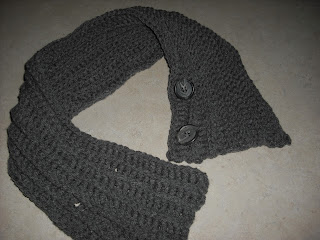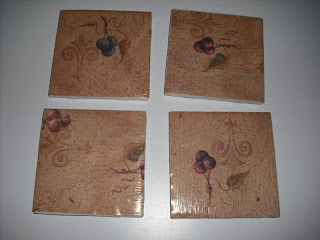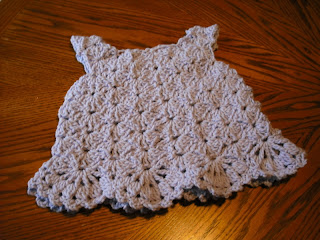Lilacs in February Baby Blanket
This is a very easy pattern, suitable for an advanced beginner. The hardest parts of it are evenly single crocheting along the sides for the first round of the border, and the reverse HDC round that finishes it.
Materials:
WW yarn 16 oz (I used a Caron pounder in lilac, and only had about 5 yards of yarn left so you may need more.)
K hook
Yarn needle for weaving in ends
Special stitch:
Cluster (worked over two stitches) – yarn over hook, insert hook in first stitch, pull up loop, yarn over hook again, insert hook in next stitch, pull up loop, yarn over hook and pull through all 5 loops on hook-1 cluster stitch made
Abbreviations:
Ch - -chain
Sc – single crochet
Dc – double crochet
Ss – slip stitch
Hdc – half double crochet
Note:
Pattern works on any even number of stitches, so you can make a blanket of any size. You could also make a scarf or a rectangular shawl from this pattern.
Gauge:
Unimportant.
My blanket is 36 inches square
Pattern:
Chain 85.
Row 1: Sc into second chain from hook and into each chain to the end (84 sc)
Alternatively, you could foundation single crochet 84 stitches.
Row 2: Ch 2, turn, DC into next stitch, * cluster over next 2 stitches, ch 1 *, repeat from * to * until you have two stitches left, DC into the last two stitches (84 stitches)
Row 3: ch 1, turn, sc into each double crochet, into the top of each cluster and into every chain stitch across (84 sc)
Repeat rows 2 and 3 for a total of 73 rows. End with row 3.
Do not finish off. Work border as follows.
Border:
Round 1: Ch 1, and do a round of sc around the entire afghan, placing 84 sc down each side and across top and bottom, and 3 sc into each corner. Join with a ss to beginning sc.
Don’t get too hung up on getting the stitch count exactly right. As long as you have an even number of stitches the pattern will work out. And if despite your best efforts, you happen to miscount and end up with an extra stitch, you can still make it work out.
Round 2: (work loosely) SS to corner stitch, ch 2, dc into same stitch, ch 1 and work 2 more dc’s into the same stitch, * cluster stitch worked over next two stitches, ch 1 *, repeat from * to * until you get to the next corner, into next corner stitch work 8 2 DC, ch 1, 2 DC *, all into the same corner stitch, and then continue with cluster stitch, ch 1 down the next side. Repeat around until you get to the beginning ch 2. Join with ss.
Note: If you ended up miscounting and end up with an extra stitch, just skip a stitch in the middle of a cluster stitch. It will barely show in the finished blanket, and it’s a lot easier than ripping out what you’ve already accomplished.
Round 2 makes a series of eyelets that you could weave a ribbon through if you were so inclined.
Round 3: Reverse HDC row
If you’ve never done this before it might take a bit of trying to get it, but once you do, you’ll be happy you did. This stitch makes an edge that looks a little like a twisted rope. I use it a lot for afghans, because I think it really makes the project. If you don’t want to bother, there’s nothing wrong with another row of SC to finish.
And I suppose if you are a glutton for punishment, you could do reverse sc. That just means you sc in every stitch, but you work backwards. It’s a lot harder on your hands and takes a lot longer than the reverse HDC, but it also looks really nice.
As you might expect from the name, reverse HDC is worked in the opposite direction that you would usually work in, from left to right, rather than from right to left. (I’m right handed, I’m not sure what direction a left handed crocheter would ordinarily work in)
And finally, here’s how to work the stitch, remember to work in the “wrong” direction:
To start: ch 2, HDC into the first ch 1 space, (which should be before a cluster), ch 1, HDC into next ch 1 space. Continue across, working a HDC into each ch 1 space, with a ch 1 between each HDC. When you get to the corner, work a HDC into each DC, skipping the ch 1 in between the two sets of DEC’s. (4 HDC’s going around each corner) Continue around until you get to where you started. Join to the beginning ch 2. I usually pull the yarn through a stitch, rather than slip stitching. Whatever looks best to you is fine.
Cut yarn and weave in ends.
Essentially reverse HDC is just a series of * HDC, ch 1 * worked backwards. Each new HDC twists around the last set of stitches, creating a twisted looking border. Rather than “standing up” the HDCs are “laying down” along the edge of the blanket. I find that it sometimes takes a little finagling to make the corners look nice. In this case I did a HDC into each of the 4 DC’s in the corners, and skipped the ch 1 in the middle of the DC’s. This picture will give you an idea of what the reverse HDC edge looks like.
Note: Pattern is untested, except by myself. Please let me know if something is unclear, or you find a mistake.
You may sell one or two items made from this pattern, but you may not sell the pattern or publish it anywhere else. Please link to the pattern if you post a picture elsewhere.

























































